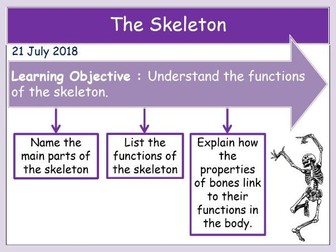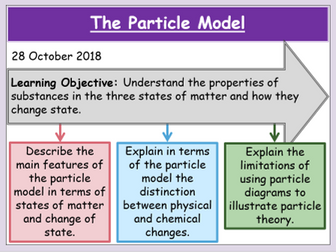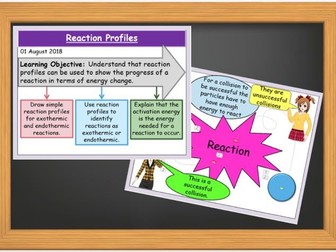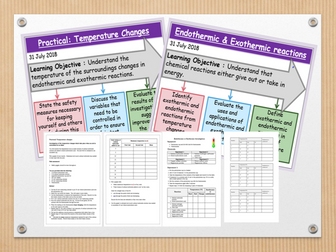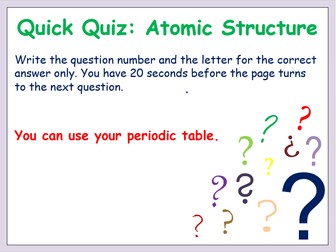Rates of reaction surface area practical
Just thought I'd share this. Ppt intro to the lesson. 2 worksheets with instructions and questions differentiated to target grade. I took the image from someone else&'s TES lesson, many thanks to them.
The Skeleton (KS3 organisms)
I thought that I’d share this Powerpoint. It’s not all my work as I’ve added some slides from other resources that I’ve come across. The build your own skeleton activity comes from the activate resource on Kerboodle so I’ve not included the worksheet for this.
The timers are from a free powerpoint by a company called A6 training and consultancy ltd.
Animal adaptations
A colourful powerpoint with hyperlinks to excellent BBC animal clips. I hope people find it useful.
Carbon Cycle Summary
Summary on a single slide with parts appearing/disappearing to keep it simple to look at. A few question on a further slide.
Physical and Chemical Barriers to infection by microorganisms. GCSE 9-1 Edexcel 5.12
This lesson consists of a PowerPoint presentation, facts sheets, a code breaker and a printable table.
It has been written for Edexcel:
5.12 Describe how the physical barriers and chemical defences of the
human body provide protection from pathogens, including:
a physical barriers, including mucus, cilia and skin
b chemical defence, including lysozymes and hydrochloric
acid.
With one final slide to briefly cover:
Explain how sexually transmitted infections (STIs) are spread
and how this spread can be reduced or prevented, including:
a Chlamydia (bacteria)
b HIV (virus)
The lesson consists of a code breaker starter followed by a definition of key terms activity. Delete as many of the clues on the codebreaker as you want to, you can therefore choose how difficult it is. A slide that introduces the idea that everyone is at risk of infection by pathogens and asks how the body defends against such an attack. Students are then given a table to complete with information on fact cards. There are questions to complete the lesson.
undefined
OCR 9-1 C1.1 Chemistry, The particle model. (Three states of matter).
This lesson has been written for the OCR 9-1 chemistry specification.
The starter asks students to complete a naming changes of state activity (there are 4 slides to choose from for this activity and a pdf handout. Or you could put the slide on the ppt and students can copy the simple triangle illustration and complete it). This requires recalling information from KS3.
The lesson then defines melting and boiling points. This is followed by an activity that requires students to identify what state of matter calcium will be at given temperatures.
The lesson then poses the question of ‘why is a solid…solid?’ This requires a knowledge of the properties of the three states of matter and students recall this information from KS3.
Students then identify the state of matter from information they are given about 4 substances.
The teacher then presents information to promote understanding of different m.p. are due to structure and type of bonding.
Change of state is then identified as a physical change and compared to chemical change. Students are introduced to the concept that physical change is still important to chemical reactions and introduced to state symbols.
The penultimate activity asks students discuss the limitations of particle theory.
The plenary is a literacy task asking for a paragraph explaining the difference in m.p. of 2 given substances. This is differentiated by the addition of key terms and a starter sentence.
I have included an activity I designed for the AQA version of this lesson. It is differentiated to a choice of 2 levels of difficulty. It challenges students to identify the contents of jars based on their state of matter. They are given the m.p. and b.p.as clues.
Atoms, Elements, Compounds KS3 quiz on powerpoint.
I created this quiz for my year 7’s who had completed the Elements, Atoms, Molecules, compounds KS3 unit.
It has 15 multiple choice questions on a powerpoint presentation.
It includes questions about the meaning of key words and identifying atoms, elements and compounds from particle diagrams.
There is 1 question per page and the students have 20 seconds to read the question and choose from 3 answers before the page automatically turns. There is a countdown to every page turn.
I created these quizzes as a fun way to reinforce main points covered in the topic so far. I had a particularly lively group and wanted to settle them down quickly at the start of the lesson and found that this worked really well.
They sit in silence for the 300 seconds of the 15 question run. I usually then choose names randomly to answer each question. It provides a good opportunity to discuss main points and clarify any misunderstandings. All my groups have embraced the quizzes really well and appear to enjoy them.
The questions may be a little too simple for top set groups, but it could confirm their understanding; which is always useful; and of course – boost their confidence!
KS3 Forces 1 multiple choice quiz on powerpoint
Use the quiz to check knowledge and understanding, reinforce key points and definitions, identify and tackle misconception and as a discussion prompt.
This is a multiple-choice quiz on powerpoint. There are 15 questions and the students have 20 seconds to write down the question number and A,B or C before the page turns to the next question. The answers are at the end.
This quiz was written for activate Forces 1. The questions are about forces, speed and include some simple calculations with an emphasis on the correct units.
I developed these quizzes for a year 7 group I taught after lunch on a Friday. They were a lively group and the quizzes worked really well to settle them down.
I wanted to introduce them to multiple choice questions as this is now a component of the GCSE. I didn’t want to hand out a sheet with a list of questions because some students will just tick a box without considering their answer.
I always tried to make it a bit fun and chose names at random (lolly pop sticks) to answer the questions at the end. It often lead to a good debate about the correct answer.
The quizzes could also be used as a plenary.
KS3 Ecosystems 1 quiz
This is a multiple-choice quiz on powerpoint. There are 15 questions and the students have 20 seconds to write down the question number and A,B or C before the page turns to the next question. The answers are at the end.
This quiz was written for activate Ecosystems 1. The questions are about food chains, plant structure and ecosystems.
I developed these quizzes for a year 7 group I taught after lunch on a Friday. They were a lively group and the quizzes worked really well to settle them down.
I wanted to introduce them to multiple choice questions as this is now a component of the GCSE. I didn’t want to hand out a sheet with a list of questions because some students will just tick a box without considering their answer.
I always tried to make it a bit fun and chose names at random (lolly pop sticks) to answer the questions at the end. It often lead to a good debate about the correct answer.
The quizzes could also be used as a plenary.
AQA 9-1 Trilogy 4.1.1 Metal Oxides. An Introduction to REDOX.
This lesson has been written for the AQA 9-1 Trilogy specificiation. Specifically for 4.1.1 Metal Oxides. It provides an introduction to REDOX and is suitable for both foundation and higher tier students. REDOX is introduced as the loss or gain of oxygen only as the idea of OILRIG is introduced at a latter stage in the specification.
The lesson requires either a class practical, demonstration or video (lots are available on you tube) of burning magnesium to engage your students and intorduce the idea of oxidation. There are equations to complete and REDOX to identify.
It is a simple lesson, but a very important start to a challenging concept.
Mass and empirical formula
Mass and Empirical formula for edexcel combined science.
A powerpoint for edexcel 9-1 combined science masses and empirical formulae. The ppt begins with bell work questions. It then:
• Recaps writing formula (what multipliers and subscripts mean).
• Clarifies the meaning of empirical and molecular formulae.
• Deducing the numbers of each element in a formula.
• Calculating relative formula mass.
• Calculating empirical formula from molecular formula.
• Molecular formula from empirical formula and mass.
There are plenty of examples on the powerpoint rather than separate worksheets, including more challenging questions for differentiation. There are 26 slides.
Ions and ionic bonding multiple choice quiz on a powerpoint presentation
This is a quiz on ions and ionic and has 15 multiple choice questions. It was written for year 9 double science GCSE students.
There is 1 question per page and the students have 20 seconds to read the question and choose from 3 answers before the page automatically turns. There is a countdown to every page turn.
I created these quizzes as a fun way to reinforce main points covered in the topic so far. I had a particularly lively group and wanted to settle them down quickly at the start of the lesson and found that this worked really well.
They sit in silence for the 300 seconds of the 15 question run. I usually then choose names randomly to answer each question. It provides a good opportunity to discuss main points and clarify any misunderstandings.
The questions may be a little too simple for top set groups, but it could confirm their understanding; which is always useful.
Acid and alkali multiple choice quiz on powerpoint - KS3
I created this quiz for my year 7’s who had completed the acids, alkali and neutralization unit.
It has 15 multiple choice questions on a powerpoint presentation.
It includes questions linking pH to weak/strong acids and alkali.
There is 1 question per page and the students have 20 seconds to read the question and choose from 3 answers before the page automatically turns. There is a countdown to every page turn.
I created these quizzes as a fun way to reinforce main points covered in the topic so far. I had a particularly lively group and wanted to settle them down quickly at the start of the lesson and found that this worked really well.
They sit in silence for the 300 seconds of the 15 question run. I usually then choose names randomly to answer each question. It provides a good opportunity to discuss main points and clarify any misunderstandings. All my groups have embraced the quizzes really well and appear to enjoy them.
The questions may be a little too simple for top set groups, but it could confirm their understanding; which is always useful; and of course – boost their confidence!
Reaction profiles, activation energy and collision theory
This lesson is written for AQA 5.5.1.2 Reaction profiles.
It discusses simple reaction profiles, collision theory and activation energy. It is a complete lesson on an animated powerpoint presentation. There are lots of tasks included in the powerpoint and details of 2 quick but excellent demonstrations. There are links to youtube videos if you prefer this to the demonstrations.
AQA 5.5.1.1 9-1 Specification. Endothermic and Exothermic reaction in terms of energy transfer
These lessons discuss endothermic and exothermic reactions.
The first lesson covers AQA trilogy 5.5.1.1 and discusses definitions relating to change in temperature, breaking and making bonds and some examples. There is a practical (based on RSC classic chemical experiments) that asks students to deduce if the reactions are endo or exo to reinforce this concept. I have included a worksheet for this.
The second lesson is the AQA required practical. I have included information taken directly from the AQA guidelines from their required practical. But have written a powerpoint to accompany it that includes an animation to assist with the graph task.
Atomic structure multiple choice quiz on powerpoint
I created this quiz for my year 9’s who had completed the first unit of their GCSE. It has 15 multiple choice questions on a powerpoint presentation.
This is a quiz on basic atomic structure.
There is 1 question per page and the students have 20 seconds to read the question and choose from 3 answers before the page automatically turns. There is a countdown to every page turn.
I created these quizzes as a fun way to reinforce main points covered in the topic so far. I had a particularly lively group and wanted to settle them down quickly at the start of the lesson and found that this worked really well.
They sit in silence for the 300 seconds of the 15 question run. I usually then choose names randomly to answer each question. It provides a good opportunity to discuss main points and clarify any misunderstandings.
The questions may be a little too simple for top set groups, but it could confirm their understanding; which is always useful.
Physics paper 1 revision game. Snakes and ladders with questions.
Turn revising for combined physics paper 1 into a game with this snakes and ladders gameboard and a large selection of questions.
The students play in groups and compete to be the first to reach the end of the gameboard. The students take it in turns to roll the dice. If they land on a question tile, they answer one of the questions. If they answer the question correctly, they go up the ladder. But if they answer incorrectly, they go down the snake. The winner is the first player to reach the end of the board.
This version of the game is aimed at revising physics paper 1 and has been written following the Edexcel combined science specification, although it can be used for any physics revision.
The questions are on motion, motion and forces, waves, light and the electromagnetic spectrum and radioactivity.
Included in the pack are:
• A copy of the gameboard both A4 and A3.
• 148 questions (and answers). There are plenty of questions for each category to allow for some targeting / levelling. Just miss out the ones you do not want to use for specific groups.
The questions will need to be printed, cut, and folded for each group. The questions and answers are on a strip so that the student asking the question can see the answer, but the student answering cannot. You can always supply only questions and challenge more able groups to decide if the answer is correct.
Ideally the questions and gameboard will be printed in colour.
The dice and counters are not included. It only takes a couple of minutes for students to draw their own counters on scraps of paper and this adds to the fun and creativity of the game.
How Science Works: Two resources for KS3.
How Science Works: Two resources for KS3.
A 15-question multiple choice quiz on PowerPoint. Also provided are a PowerPoint instruction slide and the answer grid on a PowerPoint slide. Each question has 4 possible answers, and the slide automatically advances after twenty seconds. The answers are at the end.
I designed the quiz to calm a very excitable year 7 group on a Friday afternoon. It worked well, they enjoyed the quiz, which I insisted on silence for. Then we discussed each answer at the end. It was usually a good group discussion about why some choices were incorrect and cleared up some misconceptions well.
The second resource is a key word code breaker. The code breaker activity requires students to complete a crossword style grid. The letters have been replaced by numbers and they are given a table informing them what number represents what letter.
4 versions of the code breaker are provided, differentiated by increasing the number of missing letters in the table. This makes the code breaker more challenging by requiring students to deduce the missing letters and complete the key word.
Topics covered include: Recording, analysing and evaluating data; Planning an investigation; asking scientific questions.
KS3 Earth 1 multiple choice quiz
This is a multiple-choice quiz on powerpoint. There are 15 questions and the students have 20 seconds to write down the question number and A,B or C before the page turns to the next question. The answers are at the end.
This quiz was written for activate Earth 1. The questions are about the solar system, rocks and astronomers.
I developed these quizzes for a year 7 group I taught after lunch on a Friday. They were a lively group and the quizzes worked really well to settle them down.
I wanted to introduce them to multiple choice questions as this is now a component of the GCSE. I didn’t want to hand out a sheet with a list of questions because some students will just tick a box without considering their answer.
I always tried to make it a bit fun and chose names at random (lolly pop sticks) to answer the questions at the end. It often lead to a good debate about the correct answer.
The quizzes could also be used as a plenary.
